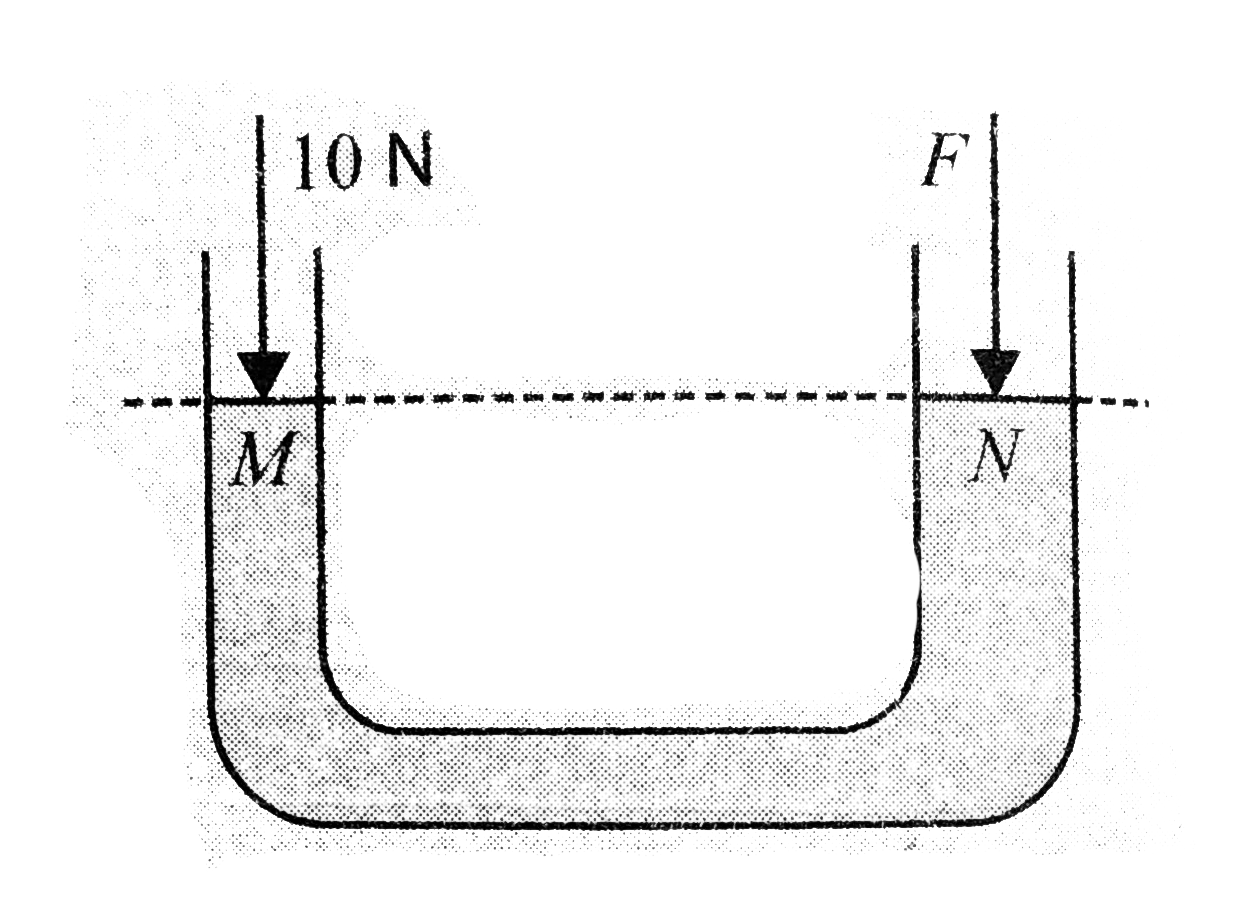The area of cross section of the two arms of a hydraulic press is 1cm2 and 20cm2 respectively. A force of 10N is applied on the water in the thinner arm. What force should be applied on the water in the thicker arms so that water may remain in equilibrium?

In equilibrium, the pressures at the two surfaces should be equal as they lie in the same horizontal level. If the atmospheric pressure is P0 and a force F is applied to maintain the equilibrium the pressur just below the pistons are
PM=P0+10N1cm2 and PN=P0+F10cm2
These pressures should be the same i.e. PM=Pnwhich gives F=200N.
Topper's Solved these Questions
- FLUID MECHANICSBOOK - CENGAGE PHYSICSCHAPTER - FLUID MECHANICSEXERCISE - Solved Examples
7 Videos
- FLUID MECHANICSBOOK - CENGAGE PHYSICSCHAPTER - FLUID MECHANICSEXERCISE - Exercise 4.1
11 Videos
- DIMENSIONS & MEASUREMENTBOOK - CENGAGE PHYSICSCHAPTER - DIMENSIONS & MEASUREMENTEXERCISE - Integer
2 Videos
- GRAVITATIONBOOK - CENGAGE PHYSICSCHAPTER - GRAVITATIONEXERCISE - INTEGER_TYPE
1 Video
Similar Questions
The area of cross section of the two arms of a hydraulilc press are 1 cm^2 and 10 cm^2 respectively figure. A force of 5N is applied on the water in the thinner arm. What force should be applied on the water in the thicker arm so that the water may remain in equilibrium?
 ,
,
View SolutionThe area of cross section of two cylinders of a Bramah press are 10cm2and50cm2, respectively. In order to move up a weight of 100 placed on the bigger piston. what force should be applied on the smaller piston of smaller area ?
View Solution
Knowledge Check
The area of cross-section of the two vertical arms of a hydraulic press are 1 cm2 and 10cm2 respectively. A force of 10N applied. As shown in the figure, to a tight fitting light piston in the thinner arm balances a force F applied to the corresponding piston in the thicker arm. Assuming that the levels of water in both the arms are the same, we can conclude:-
 AF=100NBF=50NCF=25NDF, as applied, cannot balance the effect of the force on the first piston
AF=100NBF=50NCF=25NDF, as applied, cannot balance the effect of the force on the first pistonThe radius of one arm of a hydraulic lift is three times the radius of the other arm. What force should be applied on the narrow arm so as to lift 50 kg at the wider arm?
A60 NB54.4 NC26.7 ND30 NA force of 40 N is applied on a nail, whose tip has on area of cross-section of 0.001 cm2. The pressure on the tip is
A4×108Nm−2B4×10−8Nm−2C4×104Nm−2DNone of these
How much force should be applied on an area of 1cm2 to get a pressure of 12 Pa ?
View SolutionIn a simple hydraulic press, the cross sectional area of the two cylinders is 5×10−1m2 and 10−2m2 respectively. A force of 20N is applied at the small plunger.
a. What is the pressure produced in the cylinders?
b. What is the thrust exerted on the large plunger?
c. How much work is done by the operator, if the smaller plunger moves down 0.1m?

View SolutionThe cross-section of two piston in hydraulic press are 2cm2and150cm2 respectivley . Calculate the minimum force required to support a weight of 2000kg wt on the broader face of the press.
View Solutionhow much force should be applied on an area of 1 cm2 to get a pressure of 15 Pa?
View SolutionRadius of one arm of hyddraulic lift is foud times off radius of other arm. What force should be applied on narrow arm to lift 100 kg?
View Solution
